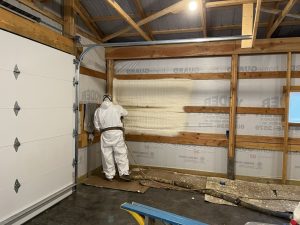Welcome to Ask the Pole Barn Guru – where you can ask questions about building topics, with answers posted on Mondays. With many questions to answer, please be patient to watch for yours to come up on a future Monday segment. If you want a quick answer, please be sure to answer with a “reply-able” email address.
Email all questions to: PoleBarnGuru@HansenPoleBuildings.com
DEAR POLE BARN GURU: Father and I are getting ready to build a 24×36 pole barn and while discussing the layout we were both wondering about sliding door placement. Visualizing the barn we would like a 12′ door or so on left side of the 36′ wall where sliding it to the right would open it (with one directly across on opposite wall so we could drive through if needed). Our question is how close to the corner of the barn should we put the door? Is it common to have door go all the way to the corner, basically where a latch could go onto the 24′ wall or is it common practice to have the door be x feet away from 24′ wall?
Very rarely if ever will a truck or car be in there (mower, 4 wheelers) so leaving space for doors to open won’t be an issue and plus if door goes all the way to corner would allow more space inside for a longer work bench along the wall.
Any recommendations? Thanks LOCATING IN LANSING
DEAR LOCATING: Typically the 36 foot sidewall of a pole building will be three “bays” each being 12 feet wide. Other than for small sliding doors for animals (think horses), my recommendation is to make the doors as wide as possible without having to relocate a structural column – in your case 12 feet. You can put the door in one of the 12’ end bays (at a corner) to leave 24’ for a long workbench. The door would then slide over the 24’ section.
The only differences in hardware for a 12 foot wide door as opposed to a door of eight, nine or 10 feet in width is length of the sliding door track itself and the steel door horizontals. In most cases the cost will be less than having to purchase an extra pressure treated post to make the opening narrower.
You might never need the extra door width yourself, but the next owner of the building might.
Mike the Pole Barn Guru
DEAR POLE BARN GURU: Hi there. I’m considering building a pole building house in Ferry County, WA. I see on your website that you recommend posts being buried, and then the concrete floor being poured after posts are all in ground. Is this method allowed for pole barn houses in Washington State, or would you need to pour a slab foundation and install posts on top of slab?
I am trying to learn the process, so I can explain it thoroughly to my wife. We are looking at building the house as a vacation/future retirement home.
Also, do you build in Eastern Washington? WONDERING IN WASHINGTON
DEAR WONDERING: Regardless of where a pole barn house will be located anywhere in the United States, properly pressure preservative treated columns can be embedded into the ground to support the building. There is no Code related reason which dictates the columns must be placed on top of a slab. This is our preferred method, although we can also design to place columns on top of a foundation with brackets, if this is what the client wishes.
And – Hansen Pole Buildings does not construct buildings anywhere, we provide complete pole building kit packages, which hare designed to be constructed by the average person who can and will read instructions. For those who do not desire to assemble themselves, installers can usually be found for about ½ of the cost of the materials.
Mike the Pole Barn Guru
DEAR POLE BARN GURU: I’m looking to build a 40x80x12 pole barn next year and I am trying to nail down some possibilities before I get too far into of the realm of wants vs cost efficiencies. I would like to have a portion of the barn living space and the rest garage. Local building inspectors have given me the green light to purse this thankfully.
My basic plan is to insulate with closed cell foam insulation in the living space and a radiant barrier (for now) in the garage area. I do have quite a few window openings planned for the living area. Does this cause any issues with your package? I don’t mind moving things around for post spacing or adding in my own framing but did not know if this was acceptable with your sidewall and endwall designs.
The plan for interior finishes is simple but with a metal panel ceiling attached to the bottom of the roof purlins. For that reason I like the look of exposed steel trussed in the living space. Is it possible for you all to design around this as well? At most the living space is 30×40 on one end. For the garage area, wood trusses are more than suitable. This is more of a look I am just trying to achieve more than structural. Thanks. WONDERING IN WHITTIER
DEAR WONDERING: Usually window openings are not going to detract structurally, unless you have a large number of them in the same endwall. Sidewall window openings are usually not an issue, as sidewall shear loads are much smaller than those on endwalls.
Others have experienced some challenges with using steel liner panels for ceilings. https://www.hansenpolebuildings.com/blog/2013/08/steel-liner-panels/
We do not use steel trusses in our buildings – the biggest issues being very few steel truss manufacturers are able to provide engineer sealed drawings for them, nor are the able to generally meet the strenuous third party inspection requirements mandated by the Building Codes. Over the years, I’ve had many clients leave wood trusses exposed – with some painting or staining and varnishing them to achieve the aesthetic look they were after.
Mike the Pole Barn Guru








